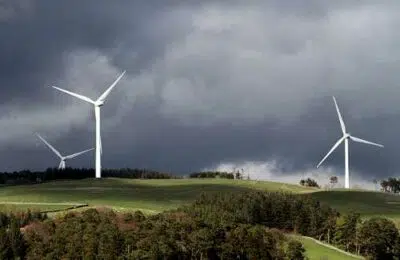Bloomberg reports that the wind energy market is in trouble. Turbine makers are struggling to make a profit. The big players, Vestas Wind Systems A/S, General Electric, and Siemens Gamesa Renewable Energy SA, are having problems making a profit due to the high cost of raw materials and logistics costs [China owns the market].
[They aren’t making any profit, but they probably have a good ESG score.]

“COLOSSAL MARKET FAILURE”
“What I’m seeing is a colossal market failure,” said Ben Backwell, chief executive officer of trade group Global Wind Energy Council, noting a mismatch between government targets for new wind power and what’s happening on the ground. “The risk is we’re not on track for net zero [emissions] — and the other risk is the supply chain contracts, instead of expanding,” reports Bloomberg.
A retreat from wind power will devastate the globalist plan of putting everyone on wind and solar power and get the temperature to 1.5 degrees Celsius by 2030. [The goal is arbitrary and does not consider the standard of living.]
They also fail to compete with China and their slave labor.
China accounts for 50% of world’s offshore wind energy capacity.
BTW, if you don’t know the answer to a stat about China, start with a guess of “50%.” #RenewableEnergy #GreenEnergy #ClimateCrisis pic.twitter.com/EqN30gfaej
— S.L. Kanthan (@Kanthan2030) September 19, 2022
Western turbine manufacturers say they’ll compete for fewer projects in fewer markets, raise prices, streamline their product lineups, and cut manufacturing costs. Even with artificially pumping up gas prices, they aren’t doing well.
“You absolutely need to see some of these profit pictures turn around for the decarbonization goals to be achievable,” said Aaron Barr, global head of onshore wind at consultancy Wood Mackenzie.
Subsidies and the CCP Contribute to the Colossal Failure
When subsidies were reduced in the mid-2010s, governments started to pull back on expansive subsidies. Without welfare, these companies can’t make it.
The pandemic didn’t help. Bureaucracy also gets in the way.
A slowdown in U.S. turbine manufacturing risks further weakening the country’s energy independence. Already, it counts on Chinese manufacturers for much of its supply of solar panels — a reliance that has contributed to trade tensions between the countries.
Now, Chinese competitors see an opportunity in the wind market. Companies, including Xinjiang Goldwind Science & Technology Co., Envision Group, and Ming Yang Smart Energy Group Ltd., plan to invest in factories abroad to take market share.
Vestas had the world’s biggest turbine, and then the CCP Ming Yang came up with a bigger one.
The research from IntelStor’s Global Wind Energy Innovation Trends report found that from a high of 200 wind turbine manufacturers in the world, today there are just 37 — of which only 18 have a “track record for a positive return on capital for at least one of their products sold.” That is a colossal fail.
However, nearly all of the major OEMs (Original Equipment makers) have reported a fall in wind turbine values over the past 18 months, with the average selling price of onshore machines falling 20% and revenues down 30%.
This will have further effects down the supply chain, as the battle to make wind power competitive with other forms of generation, and the removal of subsidies, damages profitability.
Additionally, of the 1,200 turbine models offered for sale in the past 40 years, only 11.6% (around 140) have achieved a net positive return on capital.
Vestas briefly held bragging rights for the world’s biggest turbine when it announced a 15-megawatt structure. Still, in an example of China’s increasing muscle, it was quickly overtaken when Ming Yang introduced a 16-megawatt machine in August.
Siemens had a -4% profit in the second quarter.
GE expects to post a first-quarter negative operating margin of 16%, more than double what it sustained in both the prior-year period and last year’s fourth quarter.
That is a colossal loss. Turbine makers are raising prices to keep up with the increasing prices.
Environmentalists Are Beginning to Realize Turbines Are Not So Great for the Environment
People concerned with the environment are increasingly aware of the negative impacts of the giant machines and their vast land-use requirements on wetlands, birds, bats, beneficial insects, and other wildlife. They degrade, fragment, and destroy habitats, WindWatch reports.
According to WindWatch, considering these and other impacts, the construction of industrial wind energy facilities cannot be justified in rural and wild places.
The claim that they reduce pollution or greenhouse gases appears exaggerated. The wind is fickle. They also haven’t reduced the use of fossil fuels.
Their ability to reduce carbon dioxide emissions that may contribute to climate change or pollutants that can cause acid rain and health problems is doubtful, despite their tremendous size and sprawl.
Smaller turbines make a profit because the maintenance is not as expensive. It takes fifteen years on a twenty-five-year lifespan of a small wind turbine.
All in all, wind turbines continue to be a bad investment. If they succeed, we’d be happy, but so far, we better keep our fossil fuels.
Subscribe to the Daily Newsletter



